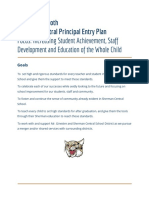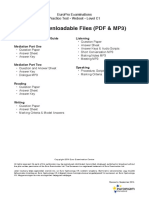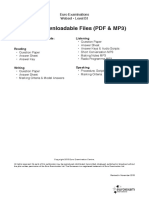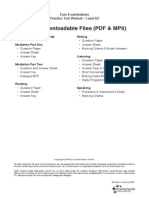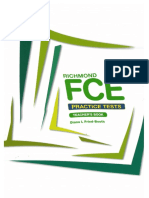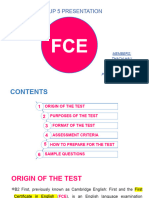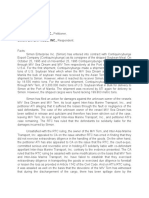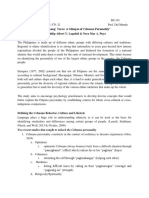00 Web c1 Exam Guide 2014
00 Web c1 Exam Guide 2014
Uploaded by
Krisztina NagyCopyright:
Available Formats
00 Web c1 Exam Guide 2014
00 Web c1 Exam Guide 2014
Uploaded by
Krisztina NagyOriginal Title
Copyright
Available Formats
Share this document
Did you find this document useful?
Is this content inappropriate?
Copyright:
Available Formats
00 Web c1 Exam Guide 2014
00 Web c1 Exam Guide 2014
Uploaded by
Krisztina NagyCopyright:
Available Formats
Euro Examinations
Practice Test • Webset • Level C1
List of Downloadable Files (PDF & MP3)
Euro C1 Examination Guide Listening
• Question Paper
Mediation Part One • Answer Sheet
• Question Paper • Answer Keys & Audio Scripts
• Answer Sheet • Short Conversation MP3
• Answer Key • Making Notes MP3
• Radio Programme MP3
Mediation Part Two
• Question and Answer Sheet Speaking
• Answer Key • Procedure, Script & Materials
• Dialogue MP3 • Marking Criteria
Reading
• Question Paper
• Answer Sheet
• Answer Key
Writing
• Question Paper
• Answer Sheet
• Marking Criteria & Model Answers
Copyright 2014 Euro Examination Centre
All rights reserved. No parts of this publication may be reproduced, distributed, transmitted, displayed, published or broadcast without
the prior written permission of the Euro Examination Ltd. The Euroexam is a registered trademark of Euro Examination Ltd.
Jelen kiadvány teljes egészében szerzői mű, az Euro Nyelvvizsga Kft. szellemi tulajdona. Bárminemű sokszorosítás vagy további
felhasználás kizárólag az Euro Nyelvvizsga Kft. kifejezett írásos hozzájárulásával engedélyezett! Az euroexam az Euro Nyelvvizsga
Kft. Magyarországon és más országokban bejegyzett védjegye.
Revised in August 2014.
Euro C1 Webset - EXAMINATION GUIDE Page 2
Euro C1 Examination Guide
The Euro and EuroPro exams test communicative competence by testing success in real communication. Exam tasks are
directly based on the Common European Framework of the Council of Europe. Passing the Euro or the EuroPro Exam
indicates that the candidate can undertake a variety of real-life tasks in English.
At Euro C1 there are five types of examination the candidate may attempt:
• Monolingual Written (Written examination without the mediation test)
• Bilingual Written (Written examination with the mediation test)
• Oral (Oral Examination only)
• Monolingual Complex (Written and oral examinations without the mediation test)
• Bilingual Complex (Written and oral examinations with the mediation test)
To pass any of these examinations the candidate must have an average mark of 60% over all the tests attempted and
score at least 40% in every test.
If the candidate fails a complex examination, but has satisfied the conditions for passing either the written or the oral
examination, s/he is awarded the written or oral examination.
Test Number of tasks Time
Mediation (Optional) 3 ca. 45’
Reading 3 45’
Writing 2 60’
Listening 3 ca. 40’
Speaking 3 10’ + 20’
Total time ca. 3 hrs 20 mins + breaks
Mediation Part One (Time: 30 minutes) Reading (Time: 45 minutes)
Dictionary use: The candidate may use a printed (i.e. Dictionary use: The candidate may use a printed (i.e.
non-electronic) dictionary throughout this task. non-electronic) dictionary throughout the Reading Test.
Task 1 – Translation English into Hungarian Task 1 – Paragraph Headings
The candidate receives a factual text or a formal letter of There are six paragraphs for which the candidate must
100-110 words, written in English. S/he has to translate find the most appropriate heading from a choice of eight
the text into Hungarian. The candidate may use a printed paragraph headings. Two headings are not needed. An
dictionary. example is provided.
Task 2 – Translation Hungarian to English Task 2 – Long Text
The candidate receives a factual text or a formal letter of The candidate reads a single text of 1000-1250 words,
100-110 words, written in Hungarian. S/he has to translate normally an article, and answers 2 - 4 questions. Each
the text into English. The candidate may use a printed question requires 2 - 4 pieces of information in the answer.
dictionary. The number of pieces of required information is indicated
on the answer sheet; the candidate should write no more
than 15 words for each piece of information. Answers are
only marked for content.
Mediation Part Two (Time: ca. 15 minutes)
Dictionary use: The candidate may use a printed (i.e.
Task 3 – Multiple-Choice Reading
non-electronic) dictionary during the last two minutes of The candidate reads two texts (ca. 400 words each) of
the test after the audio has finished. which one is a formal article. Both texts have a shared
theme. Each text has three multiple-choice questions. The
questions test the understanding of detailed information,
Dialogue
a specific lexical item, meaning implied in the text and the
The candidate hears a dialogue of 8 turns including writer’s attitude.
two examples between two participants, a Hungarian
(speaking in Hungarian) and an English speaker (speaking
in English). One of the speakers may be an official. The
candidate writes down the main points of the conversation
in the opposite language to the one s/he hears. Two
examples are given.
Page 3 Euro C1 Webset - EXAMINATION GUIDE
Writing (Time: 60 minutes) Speaking (Time: 10 min preparation + 20 mim
examination)
Dictionary use: The candidate may use a printed (i.e.
non-electronic) dictionary throughout the Writing Test. Dictionary use: The candidate may use a printed (i.e.
non-electronic) dictionary during the preparation period
only.
Task 1 – Transactional Writing
Candidates are examined in pairs. There are two
The candidate reads several pieces of written or
examiners: one an interlocutor, the other an assessor. The
diagrammatic text (e.g. leaflets, notes, letters, maps,
candidate has ten minutes before the test for preparing
timetables) providing a context and information for
Task 2. Candidates may use printed (i.e. non-electronic)
the task. The candidate is asked to write a ca. 200
dictionaries.
word transactional letter or email using the information
provided.
Task 1 – Interview
Task 2 – Discursive Writing The candidate in a pair has a two-minute conversation
with his/her partner. If they don’t know each other, they
There are three tasks from which the candidate chooses
find out information about the other candidate. If they do,
one. The candidate must write a ca. 200 word text within
they compare the things they have in common.
the genre specified. At present the tested genres are: an
article, a letter to the editor, a review and an essay.
Task 2 – Presentation & Discussion
In the preparation room the candidate has ten minutes
Listening (Time: ca. 40 minutes) to choose one of two statements and to prepare a two-
minute presentation. The statements are contentious,
and the candidate needs to marshal arguments for
Dictionary use: The candidate may use a printed (i.e.
and against the statement and to conclude by giving a
non-electronic) dictionary during the last five minutes of
reasoned opinion. The candidate is not judged on his/her
the test after the audio has finished.
opinion, but on the quality of his/her English and the logic
of argument. No specialised knowledge is required. When
Task 1 – Short Conversations giving the presentation, the candidate may consult, but
not read from, his/her notes.
The candidate listens twice to four short conversations
occurring in the same location and matches each one While one candidate is giving the presentation the other
with an item from List A and an item from List B. List B candidate will take notes. After the presentation, the other
often consists of the attitude or psychological state of one will ask questions and make points on what the candidate
of the speakers. Each list has two items which are not has said. The candidate responds to these points. One
needed. minute is allowed for this discussion.
The same procedure is repeated vice versa for the other
Task 2 – Making Notes candidate.
The candidate listens to a recorded monologue, usually a
lecture, in three parts. Before each part the student hears Task 3 – Discussion
a recorded question. While listening to the monologue
The pair of candidates receives a card with four
the candidate must note down three pieces of information
thematically linked photographs. These photographs are
which are required to answer the question. At the end
possible illustrations for the cover of a book, a poster, etc.
of each section the question is repeated and there is a
on a given subject. First, they discuss which aspect of
pause for writing. The recording is played only once.
the topic each picture portrays. Then the two candidates
debate which is the most suitable. Finally they discuss
Task 3 – Radio Programme any other suitable images for the book. Three minutes is
allowed for this task.
The candidate listens twice to an excerpt from a radio
programme. The candidate answers eight multiple-choice
questions while listening. The programme will typically be
a talk show or formal discussion.
You might also like
- Euroexam Angol - Practice Test B2 (Középszint) - Set 3Document80 pagesEuroexam Angol - Practice Test B2 (Középszint) - Set 3Sztr Tzsr80% (5)
- Ahead With CPEDocument28 pagesAhead With CPETrongTan88% (40)
- TB - Ahead With CPE KeyDocument28 pagesTB - Ahead With CPE KeyLaura100% (33)
- Euroexam B2 Practice TestDocument63 pagesEuroexam B2 Practice TestHajnalcsillag95% (40)
- Euro C1 Teachers BookDocument121 pagesEuro C1 Teachers BookTundike100% (2)
- Principal Entry PlanDocument5 pagesPrincipal Entry Planapi-324877768No ratings yet
- Introduction To Linguaskill SlidesDocument37 pagesIntroduction To Linguaskill SlidesAhmed Hassan100% (1)
- All About IELTS: Step by Step Practical Guide to Crack IELTSFrom EverandAll About IELTS: Step by Step Practical Guide to Crack IELTSRating: 5 out of 5 stars5/5 (3)
- Euro C1 Exam GuideDocument3 pagesEuro C1 Exam GuideKrisztina KuruczNo ratings yet
- Syllabus of Diploma in Translation 2014-15Document5 pagesSyllabus of Diploma in Translation 2014-15HARSH ARORANo ratings yet
- 04 - FCE - B2 First Exam Format - Writing - Paper 2 - Cambridge EnglishDocument2 pages04 - FCE - B2 First Exam Format - Writing - Paper 2 - Cambridge EnglishBernadete100% (1)
- Metu - SFL English Proficiency Examination A Guide For Test-TakersDocument99 pagesMetu - SFL English Proficiency Examination A Guide For Test-TakersBurak BuranNo ratings yet
- MAE 409A Finite Element Methods 1 Final LabDocument21 pagesMAE 409A Finite Element Methods 1 Final LabChris OrozcoNo ratings yet
- Konica-Minolta - Bizhub 200,250,350 - Parts (2005) PDFDocument100 pagesKonica-Minolta - Bizhub 200,250,350 - Parts (2005) PDFJonathan LongNo ratings yet
- List of Downloadable Files (PDF & MP3) : Euro Examinations Webset - Level B1Document3 pagesList of Downloadable Files (PDF & MP3) : Euro Examinations Webset - Level B1alexNo ratings yet
- List of Downloadable Files (PDF & MP3) : Euro Examinations Practice Test Webset - Level B2Document3 pagesList of Downloadable Files (PDF & MP3) : Euro Examinations Practice Test Webset - Level B2Anonymous blS7rZFtcNo ratings yet
- Exam GuideDocument4 pagesExam GuidePetra VarróNo ratings yet
- 00 B2pro Web Contents & Exam Guide PDFDocument3 pages00 B2pro Web Contents & Exam Guide PDFanyus1956No ratings yet
- 00 B1 Practice Test 1 IntroductionDocument6 pages00 B1 Practice Test 1 IntroductionsalvaNo ratings yet
- Euro C1 Teachers Book WEB PDFDocument121 pagesEuro C1 Teachers Book WEB PDFMary CsNo ratings yet
- B2 First Info + SpeakingDocument2 pagesB2 First Info + SpeakingAg GyNo ratings yet
- 00 Set 2 C1 INT 500 IntroductionDocument6 pages00 Set 2 C1 INT 500 IntroductionHair8No ratings yet
- Ahead With: For SchoolsDocument28 pagesAhead With: For SchoolsHelena Ferreira100% (1)
- C1 Advanced Exam Format: Playlist What's in The Listening Paper?Document2 pagesC1 Advanced Exam Format: Playlist What's in The Listening Paper?MklptFrsw0% (1)
- Richmond Fce Practice Tests TBPDFDocument66 pagesRichmond Fce Practice Tests TBPDFTriết NguyễnNo ratings yet
- 01 Set 1 C1 Third CoverDocument5 pages01 Set 1 C1 Third CoverRéka SzántóNo ratings yet
- C1 Advanced Exam Format - Cambridge EnglishDocument3 pagesC1 Advanced Exam Format - Cambridge EnglishMichele DalfovoNo ratings yet
- SmartMech ProvedesameDocument72 pagesSmartMech ProvedesameCaro MariaNo ratings yet
- Group 1 (CAE Exam)Document29 pagesGroup 1 (CAE Exam)quanismeeeNo ratings yet
- B2 First For Schools Exam FormatDocument4 pagesB2 First For Schools Exam FormatHerminia RomeroNo ratings yet
- Presentación OTE Oxford Test of EnglishDocument9 pagesPresentación OTE Oxford Test of EnglishLinamontanariveraNo ratings yet
- Guide For Students - ISE II - Online EditionDocument16 pagesGuide For Students - ISE II - Online EditionAlicia MuñozNo ratings yet
- A1-B1-Handbook GatehouseDocument18 pagesA1-B1-Handbook Gatehousemariajo2712No ratings yet
- International English TestsDocument7 pagesInternational English Teststrandanganhhao269No ratings yet
- Fce (First Certificate in English)Document15 pagesFce (First Certificate in English)ioli6100% (1)
- SPEAKINGDocument84 pagesSPEAKINGm-12403663No ratings yet
- 2015 180143 First For Schools Information For CandidatesDocument16 pages2015 180143 First For Schools Information For CandidatesViki RincónNo ratings yet
- Pro-Elt Briefing For TrainingDocument18 pagesPro-Elt Briefing For TrainingCikgu Siti100% (1)
- 03 - FCE - B2 First Exam Format - Reading and Use of English - Paper 1Document3 pages03 - FCE - B2 First Exam Format - Reading and Use of English - Paper 1Bernadete100% (1)
- Cambridge Advanced Plus 2 Tests 1, 2, 3 & 4 PDFDocument96 pagesCambridge Advanced Plus 2 Tests 1, 2, 3 & 4 PDFAJ STYLES100% (4)
- Cambridge English Key 7Document176 pagesCambridge English Key 7yiwihor874No ratings yet
- 0510-Syllabus OverviewDocument7 pages0510-Syllabus OverviewGaiudhanaNo ratings yet
- Guide For Students - IsE III - Third EditionDocument16 pagesGuide For Students - IsE III - Third EditionFernando Hori AutránNo ratings yet
- Fce Practice TestsDocument3 pagesFce Practice Testsjmaurp100% (1)
- KC 2Document13 pagesKC 2Jay PatelNo ratings yet
- Malaysian University English Test (Muet) : General Regulations 1. Test DatesDocument14 pagesMalaysian University English Test (Muet) : General Regulations 1. Test DatesRevathi ManiamNo ratings yet
- Modern Foreign Languages FRENCH (27) : AimsDocument6 pagesModern Foreign Languages FRENCH (27) : AimsjohnsondiusNo ratings yet
- VtsepDocument52 pagesVtsepNguyễn Hồng Nhật VinhNo ratings yet
- Guide To Using The TestsDocument2 pagesGuide To Using The TestsDinh Thi Thuy TrangNo ratings yet
- English Proficiency Exam A Guide For TesDocument113 pagesEnglish Proficiency Exam A Guide For TesHoussam AoufNo ratings yet
- EIC 4 - Test Format and Content - 07.07.2021 - OnlineDocument1 pageEIC 4 - Test Format and Content - 07.07.2021 - OnlineDuy NguyenNo ratings yet
- CAE Tips and Strategies + Useful Links 2020Document29 pagesCAE Tips and Strategies + Useful Links 2020lucia.rovi07No ratings yet
- TIE-B2-C2-Handbook-v1.1Document16 pagesTIE-B2-C2-Handbook-v1.1irodotosmNo ratings yet
- GROUP 5 - FCE (Autosaved)Document50 pagesGROUP 5 - FCE (Autosaved)katieNo ratings yet
- Fce HB Over GlossDocument2 pagesFce HB Over GlossOlga Nikitina El HageNo ratings yet
- Guidelines - For - Final Test - Grammar 1Document3 pagesGuidelines - For - Final Test - Grammar 1huychuonglisaNo ratings yet
- Cambridge English: First (FCE) Listening Part 2: Teacher's NotesDocument4 pagesCambridge English: First (FCE) Listening Part 2: Teacher's NotesRoger mandujano macedoNo ratings yet
- The Paper Protocol: Systematic Instructions for Writing a Biomedical Research PaperFrom EverandThe Paper Protocol: Systematic Instructions for Writing a Biomedical Research PaperNo ratings yet
- Advanced Students’ Knowledge of Vocabulary in a First and Second LanguageFrom EverandAdvanced Students’ Knowledge of Vocabulary in a First and Second LanguageNo ratings yet
- TOEFL iBT Premium with 8 Online Practice Tests + Online Audio, Eighteenth EditionFrom EverandTOEFL iBT Premium with 8 Online Practice Tests + Online Audio, Eighteenth EditionRating: 5 out of 5 stars5/5 (1)
- Research Methodology MCQDocument6 pagesResearch Methodology MCQKopano Marvin100% (1)
- PTI Assignment 10Document1 pagePTI Assignment 10Jonathan WagnerNo ratings yet
- Business RulesDocument2 pagesBusiness RulesCosminaStancalaNo ratings yet
- Summer Stay On Track Grades 2 To 3Document68 pagesSummer Stay On Track Grades 2 To 3Gabe Coron100% (4)
- Prophetic Irresponsibility: by Bryan HuppertsDocument3 pagesProphetic Irresponsibility: by Bryan HuppertsEyemanProphetNo ratings yet
- Lesson 1 Philosophical Perspective of The SelfDocument26 pagesLesson 1 Philosophical Perspective of The SelfJoseph PorteNo ratings yet
- Gmail - (IKDD News) Uplink 2024 - Applications Open For IKDD Research Internship ProgramDocument3 pagesGmail - (IKDD News) Uplink 2024 - Applications Open For IKDD Research Internship Programsuhelkhan900500No ratings yet
- MUHS synopsis 07-08Document27 pagesMUHS synopsis 07-08drsachinpatil2513No ratings yet
- Biochemistry of CancerDocument20 pagesBiochemistry of CancerJimmy WongNo ratings yet
- University School of Business Bachelor of Business AdministrationDocument13 pagesUniversity School of Business Bachelor of Business AdministrationShivam GuptaNo ratings yet
- Extra 10Document8 pagesExtra 10Thị Mai Huyền NguyễnNo ratings yet
- AirFree Ref & Airconditioning ServicesDocument16 pagesAirFree Ref & Airconditioning ServicesAirFree Ref and Airconditioning ServicesNo ratings yet
- War Is Sexy Sample GameDocument12 pagesWar Is Sexy Sample GameCharles CameronNo ratings yet
- Asian Terminals Vs Simon EnterprisesDocument2 pagesAsian Terminals Vs Simon EnterprisesMichelle Montenegro - AraujoNo ratings yet
- Panchvidh Kashay KalpanaDocument53 pagesPanchvidh Kashay KalpanashreerangayurvedNo ratings yet
- Partnership MatrixDocument2 pagesPartnership MatrixcharshumNo ratings yet
- Wands & Wizards - 5e Adaptation v1.2Document113 pagesWands & Wizards - 5e Adaptation v1.2Reese67% (3)
- Google Shopping Guide 20161Document24 pagesGoogle Shopping Guide 20161Andrea Fleur Du MalNo ratings yet
- Batu MenangisDocument1 pageBatu MenangisskylarkyuNo ratings yet
- BS 101 Write UpDocument6 pagesBS 101 Write UpJerico RiveraNo ratings yet
- Ecocriticism Sample Research ResultsDocument1 pageEcocriticism Sample Research ResultsAnonymous FHCJucNo ratings yet
- Book Report - Marketing To WomenDocument41 pagesBook Report - Marketing To WomensanjcileNo ratings yet
- Persuasive SpeechDocument22 pagesPersuasive SpeechSTEPHEN JAMES RONCESVALLES LIZA100% (1)
- Introduction To Greek DramaDocument3 pagesIntroduction To Greek DramalblazquizNo ratings yet
- Course Plan HCIDocument9 pagesCourse Plan HCISathyanarayananNo ratings yet
- Hazrat Muhammad (SAW) The Model of ToleranceDocument5 pagesHazrat Muhammad (SAW) The Model of ToleranceTahir ShahNo ratings yet
- Final Research Project (FRP) SynopsisDocument4 pagesFinal Research Project (FRP) SynopsisShreshth SharmaNo ratings yet






